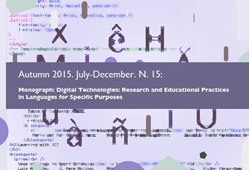Uso de tecnologías de tinta digital para facilitar la interacción en un curso de alemán para ingenieros
DOI:
https://doi.org/10.7203/attic.15.5158Palabras clave:
investigación educativa, tecnología educativa, tinta digital, interacción en el aula, alemán para ingenieros. Resumen
Resumen
Aprender una lengua usando la tableta y la tinta digital como medio de comunicación con el profesor y con los demás compañeros, aporta acción y, en consecuencia, también motivación, al proceso de enseñanza-aprendizaje. Si el discente tiene más oportunidades de participar en el aula mediante el uso de esta herramienta, ¿puede mejorar su aprendizaje de la lengua alemana? Esta es la pregunta que pretendemos responder con nuestra investigación. Los datos obtenidos muestran la conveniencia de aprovechar estas tecnologías, ya que la atención prestada a tres elementos lingüísticos fundamentales en el aprendizaje de la lengua alemana mediante la tinta digital y el software libre Classroom Presenter ha ofrecido buenos resultados, tanto en las pruebas diagnósticas, como en la valoración expresada por los estudiantes.
 Citas
Citas
AlRegib, Ghassan et al. (2008): Technology and Tools to Enhance Distributed Engineering Education. Proceedings of the IEEE 96.6, pp.951-969. http://www.ece.gatech.edu/research/labs/msl/publications/PDFs/Ghassan-PI-2008-6.pdf http://dx.doi.org/10.1109/JPROC.2008.921610
Boyer, Ernest L. (1990): Scholarship reconsidered: Priorities of the professoriate. New York: The Carnegie Foundation for the Advancement of Teaching.
Boshier, Roger; Huang, Yan (2008): In the House of Scholarship of Teaching and Learning (SoTL), teaching lives upstairs and learning in the basement. Teaching in Higher Education 13.6, pp.645-656.
http://www.tandfonline.com/doi/full/10.1080/13562510802452368 http://dx.doi.org/10.1080/13562510802452368
DOI:10.1080/13562510802452368
Chaudron, Craig (2000): Métodos actuales de investigación en el aula de segundas lenguas” En C. Muñoz (ed.), Segundas Lenguas: Adquisición en el aula. Barcelona: Ariel, pp.127-162.
Daly, F., et al. (1995): Elements of Statistics. Wokingham: Open University/Addison Wesley.
Deal, Ashley (2007): Classroom Response Systems, A Teaching with Technology White Paper. Office of Technology for Education, Carnegie Mellon University, November 2007. 16 April 2014, http://www.cmu.edu/teaching/resources/PublicationsArchives/StudiesWhitepapers/ClassroomResponse_Nov07.pdf.
Diehl, Erika, et al. (2000): Grammatikunterricht: Alles für der Katz?. Tübingen: Max Niemayer Verlag.
Eckert, Johannes; Riemer, Claudia (2000): Awareness und Motivation: Noticing als Bindeglied zwischen kognitiven und affektiven Faktoren des Fremdsprachenlernens. En C. Riemet (ed.), Kognitive Aspekte des Lehrens und Lernens von Fremdsprachen. Tübingen: Gunter Narr Verlag, pp.228-246.
Itoh, Reiko (2006): Use of Handwriting Input in Writing Instruction for Japanese Language. En D. Berque, J. Prey y R. Reed (eds.), The impact of tablet PCs and pen-based technology on education: vignettes, evaluations and future directions. EdsWest Lafayette: Purdue University Press, pp.87-93.
Martín Peris, Ernesto (1998): El profesor de lenguas: papel y funciones. En A. Mendoza (ed.), Conceptos clave en didáctica de la lengua y la literatura. Barcelona: SEDLL, ICE Universitat de Barcelona, pp.87-100.
Mckenzie, Wendy; Franke, Katharina (2009): Active, Constructive, Interactive: How are Tablet PCs Transforming the Learning Experience in Higher Education?. En Australasian Tablets in Education Conference, Monash University. 3-4 December 2009. 16 April 2014, http://www.monash.edu/eeducation/assets/documents/atiec/2009atiec-wendymckenzie.pdf.
Medina Rivilla, Antonio (1989): Didáctica e interacción en el aula. Madrid: Cincel.
Morales, Pedro (2014). Investigación e Innovación Educativa. REICE. Revista Iberoamericana sobre Calidad, Eficacia y Cambio en Educación, 8 (2), pp. 47-73. 16 abril 2014
http://www.rinace.net/reice/numeros/arts/vol8num2/art3.pdf.
Núñez-Delgado, Pilar; Constanzo Inzunza, Eduardo (2010): La interacción didáctica y la integración de destrezas en la enseñanza de las lenguas: bases para una pedagogía del texto. Interacció comunicativa i ensenyament de llengües: pp.175-182 http://digibug.ugr.es/handle/10481/24080
Reinhard, Andrew (2008): From Slate to Tablet PC: Using New Technologies to Teach and Learn Latin and Greek. Classical Journal Forum Online, March 2008. 14 April 2014, https://ascsa.academia.edu/AndrewReinhard.
Savas, Perihan (2014): Tablet PCs as instructional tools in English as a foreign language education. TOJET: The Turkish Online J. Educational Technology 13.1, pp.217-222. http://www.tojet.net/articles/v13i1/13120.pdf
Taele, Paul, and Tracy Hammond (2013): Enhancing Instruction of Written East Asian Languages with Sketch Recognition-Based Intelligent Language Workbook Interfaces. Workshop on the Impact of Pen & Touch Technology on Education (WIPTTE), Los Angeles, CA. 14 April 2014, http://wiptte.cse.tamu.edu/publications/2013/2013_WIPTTE_Full_Taele_EIWEALSRBILWI.pdf.
Trigwell, Keith; Shale, Suzanne (2004): Student learning and the scholarship of university teaching. Studies in Higher Education 29, pp.523–536. http://dx.doi.org/10.1080/0307507042000236407
Schumann, John H. (1994). Where is Cognition?, Studies in Second Language Acquisition, 16, pp.231-242. http://dx.doi.org/10.1017/S0272263100012894
Yamasaki, Toshinori; Inami, Nobuhito (2004): Training System for Fair Handwriting of Japanese Characters Based on On-Line Character Recognition. En L. Cantoni y C. McLoughlin (eds.), Proceedings of World Conference on Educational Multimedia, Hypermedia and Telecommunications 2004. Chesapeake, VA: AACE, pp.1692-1698.
Descargas
Archivos adicionales
Publicado
Número
Sección
Licencia
Todos los artículos de la revista, están sujetos a una licencia Creative Commons del tipo Reconocimiento - NoComercial - Sin Obra Derivada
